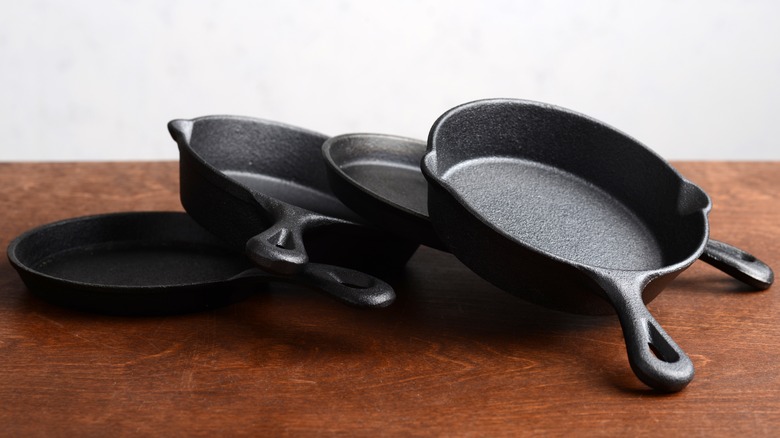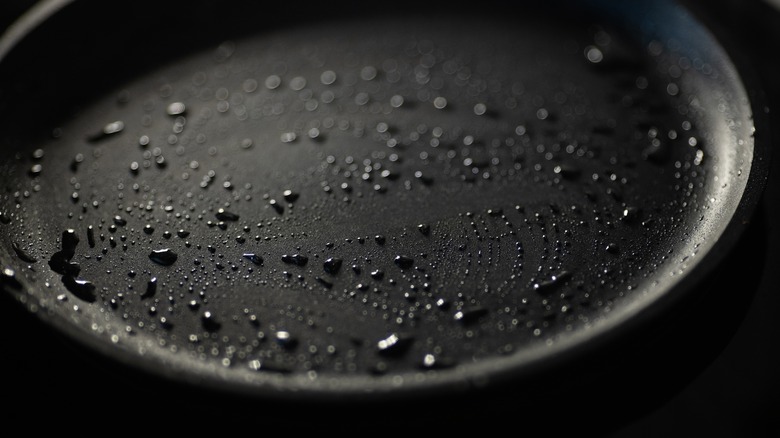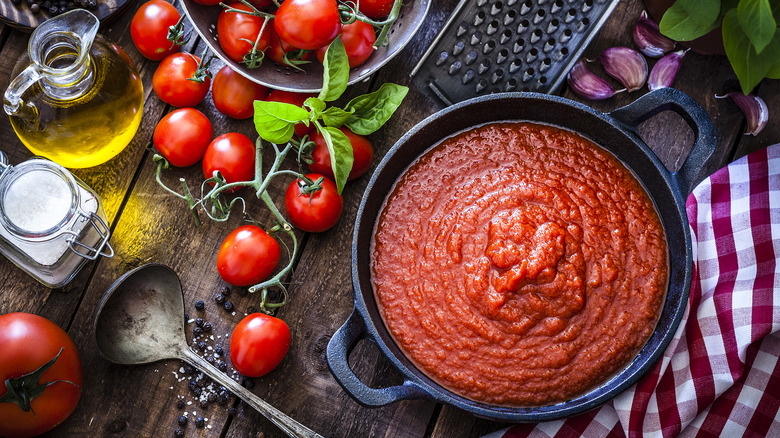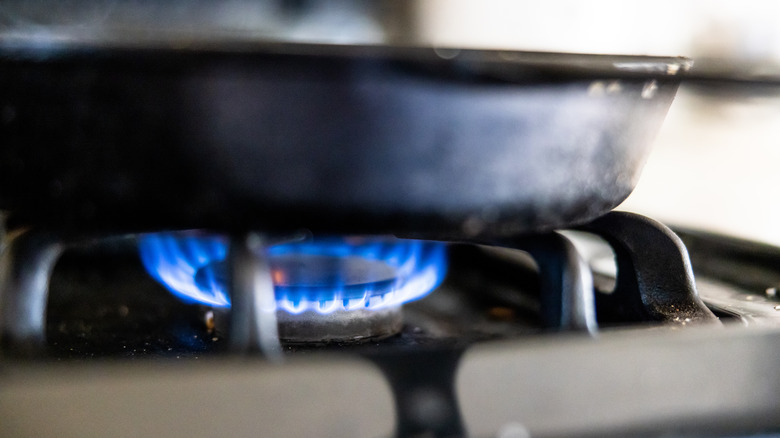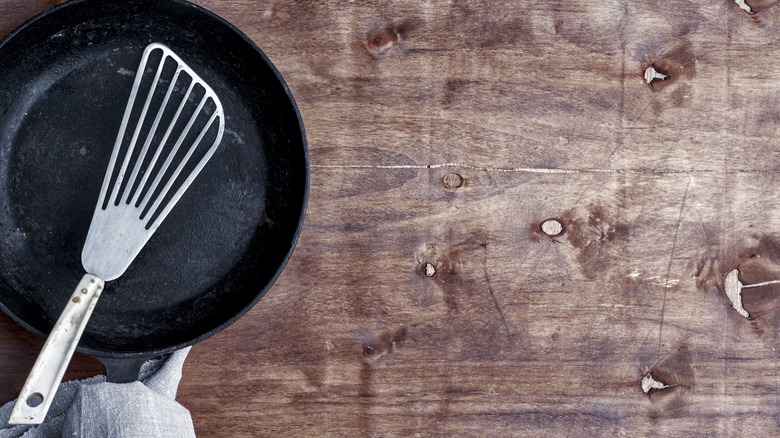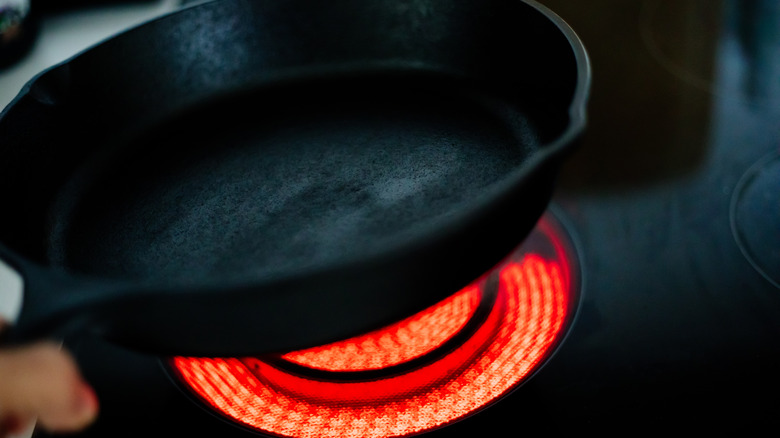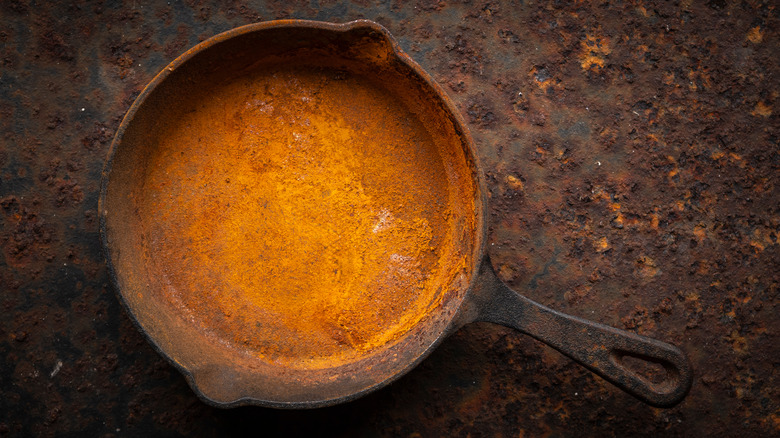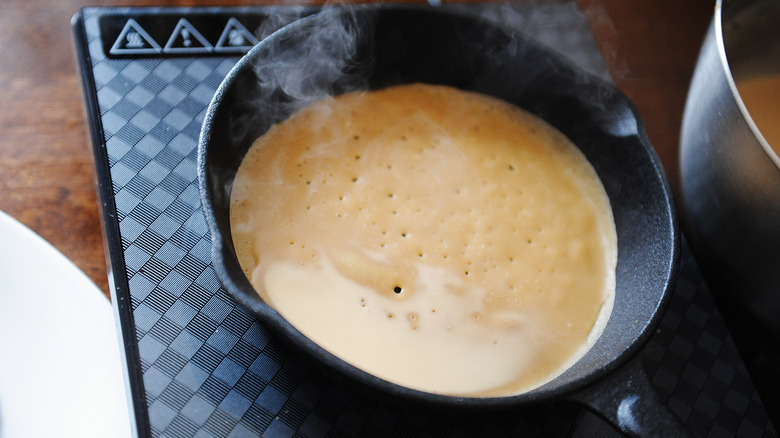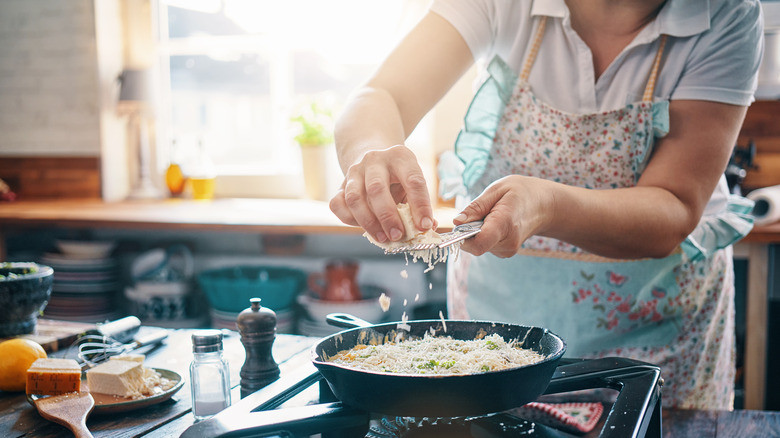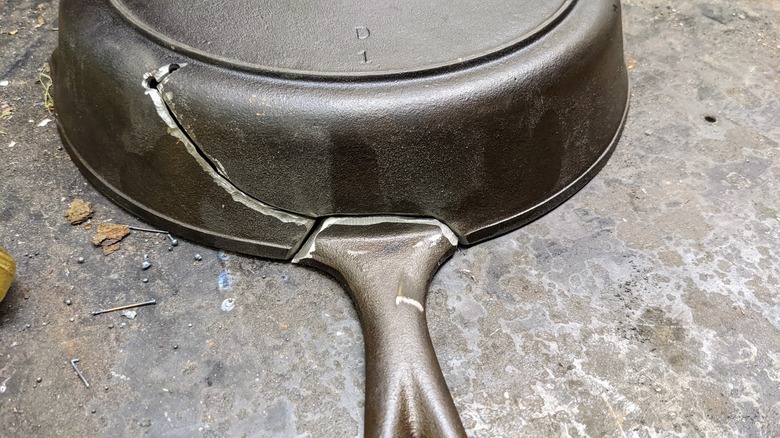Common Myths About Cast Iron Skillets You Need To Know
Throughout history, cast iron pans have been the go-to cookware for cooking over the fire. Thanks to its robust build that can withstand high temperatures, it spread across continents: from the original Chinese wok in 200 B.C. to Dutch ovens in Europe in the 18th century and the earliest skillets in the U.S. popularized in the 19th century. You can still find those skillets made by original cast iron brands like Griswold and Wagner Ware — looking as gorgeous today as they were 100 years ago.
Cookware that was once in every household is now returning to the spotlight after a little break. Despite this, there still seems to be some awkwardness surrounding the use of cast iron skillets: For some, they seem unapproachable and maintenance-heavy, while others fear damaging their glass stove. Cast iron can be rough around the edges if you're not careful, but most common myths about cast iron cookware come from poor research or biases. We've gathered them all and put them to the test. So read on, and you'll find why you shouldn't believe everything you hear about cast iron skillets.
Myth: Cast iron skillets are nonstick
One of the most common myths about cast iron skillets is that they are nonstick. If you believe that seasoning a cast iron skillet will achieve a foolproof, slick surface that you can cook anything on without sticking, we have some bad news for you. Cast iron skillet will never be as efficient as Teflon or other modern nonstick coatings and for a simple reason.
Cast iron has a rough and porous surface. When you season a cast iron skillet with a thin layer of oil, you fill some of the pores and create a protective barrier against rust, corrosion, and sticking. However, this layer does not completely smooth out the surface of the pan. Unless you own an old cast iron pan (like from the beginning of the last century), there will always be some tiny bumps and crevices left on the surface that can trap food particles. However, the smooth finish, used in pan manufacturing until the '50s, retains far better non-stick qualities than most modern skillets today.
Nevertheless, cast iron skillets can still be an excellent choice for your kitchen. Compared to stainless steel or aluminum pans, cast iron offers fairly good nonstick abilities, especially if it's properly seasoned and preheated before cooking. But, don't expect to throw an egg on it with no oil and then have the egg easily slide off — that just isn't going to happen.
Myth: You can't use soap to clean a cast iron skillet
Cast iron skillets are valued for their sturdiness and versatility. But, when it comes to cleaning them, there's often a lot of confusion. Soap is regarded as the biggest enemy of cast iron, thinking it will damage the seasoning and lead to rusting. Rest assured, however — soap should be the least of your worries when maintaining your cast iron skillet.
The truth is seasoning is more than just a simple oil; it is a thin layer of fat that becomes polymerized onto the metal surface of the pan when heated. This chemical reaction transforms the oil molecules into a complex, robust coating that regular soap isn't strong enough to break. The only sure way to remove the seasoning is by exposing the pan to extremely high heat. Soap won't harm your skillet unless you clean your pan with abrasive scrubbers or steel wool.
When it comes to rust, soap actually helps to prevent it by eliminating dirt and grease that could trap moisture on the pan. Just remember to always dry the pan thoroughly after washing it.
Myth: You can't cook acidic foods in a cast iron skillet
It is true that iron reacts with acidic foods like tomatoes, lemons, or wine. Unlike soap, acid can eventually break through the pan's seasoning, exposing the iron and causing them to react. Although not dangerous, this reaction can produce an unpleasant metallic taste and dull your food. But, that doesn't mean you can never cook acidic foods in your skillet. You certainly can, as long as you follow a few simple guidelines.
First of all, you need to make sure that your cast iron skillet is well-seasoned. The more established seasoning you have on your pan, the less likely acidic foods will be able to penetrate it. Next, it is crucial to limit the amount of time that acidic foods are in contact with your cast iron skillet. You can cook acidic foods in this type of cookware for up to 30 minutes without experiencing any issues. But, if you cook for longer or let the food sit in the pan after cooking, you may end up with an unpleasant taste. So, for longer-simmering sauces or stews, it might be worth considering using stainless steel or enameled cast iron.
Myth: Cast iron skillets heat evenly
There is a common misconception that iron skillets have a good heat distribution across the entire surface of the pan. The reality is slightly different, however: Cast iron skillets are poor heat conductors prone to hot spots and cold spots, especially when heated quickly over high heat.
Sprinkling flour on a hot pan can show significant temperature variations across a cast iron skillet. Depending on their distance from the heat source and the shape of the pan, some parts of the pan may get hotter or cooler than others. This is because cast iron is relatively thick and heavy and takes much longer to heat up than pans made of copper or aluminum.
For best results with your cast iron, preheat your skillet for up to 10 minutes. A good idea is to increase the heat gradually rather than blasting the pan with high heat. Or if you're searing meat, you could listen to Samin Nosrat's advice, author of "Salt Fat Acid and Heat," who told The Washington Post that she likes heating up her cast iron "in a blasting hot oven for at least 20 minutes" before transferring it to the stovetop — a method requiring great courage and confidence.
Myth: You can't use metal utensils on a cast iron skillet
When choosing your cast iron cookware, you'll inevitably face a question of which utensils to use. Many people may advise against using metal utensils, but the truth is the well-seasoned surface of a cast iron skillet is incredibly resilient and difficult to scratch. If anything, metal utensils can provide you with better control and precision, particularly when handling delicate foods.
The best metal utensils to use with cast iron are those with smooth and rounded edges. If you are mindful, they will never create scratches or gouges in the seasoning layer. Instead, they'll easily glide over the surface of the pan, making tasks like flipping, stirring, or scraping food effortless. What you want to avoid doing, though, is using any utensils with sharp or pointy edges, like knives or forks, as they can easily pierce through the seasoning layer and expose the bare metal underneath. Just bear in mind that if you expose your pan to heavy use regularly, you'll have to renew your seasoning more often.
Myth: You can't use a cast iron skillet on an electric stove
It is common to believe that cast iron cookware cannot be used on electric stoves. While it is true that you will need to be super conscious when moving around with it, there is no technical reason why you cannot use a cast iron skillet on your electric stove.
Cast iron is a robust cooking material that works well with most gas and electric stoves. However, it also has some quirks you must be mindful of. Cast iron is heavy and rough, which means it can scratch or crack the glass or ceramic surface of the electric stove if you're not careful. To avoid this, gently lift and lower your cast iron skillet, and never drag it around while cooking.
Also, cast iron takes longer to respond to temperature changes, so your skillet will not cool quickly. Most electric stoves have the same issue: They remain hot long after you've turned off the heat. This means that if you leave your cast iron on an electric stove, it will continue to cook your food much longer than you would anticipate. Or, if you leave your pan empty on the stove, you can easily burn yourself, so be mindful of this.
Myth: You can't restore a rusty cast iron skillet
If one day your cast iron pan develops some rust, don't fret — it's not the end of the road. It's still salvageable, and there's absolutely no need to throw the pan away. Cast iron cookware is not eternal but can last for decades or centuries if maintained well. So, if you ever inherit an old rusty cast iron, know you can give it a second chance.
Rust is a form of iron oxide that forms on the metal surface when iron reacts with oxygen and water. It can affect the appearance and performance of your cast iron cookware, but rarely will it significantly affect the thick metal of your skillet. It can happen, but the conditions would have to be very favorable for the rust to eat away the metal. A moderately rusty cast iron skillet can usually be brought back to life by simply scrubbing it with vinegar or lemon juice.
The most painless way is to soak the pan in vinegar and water for an hour, then use steel wool and dish soap to scrub off the rust. After that, you just need to rinse the pan and dry it thoroughly. Remember: Once you remove the rust, you must re-season the pan to protect it from further corrosion.
Myth: You can't use a cast iron skillet for delicate foods
We don't want to give you false hopes: Cast iron will never outperform a non-stick surface when handling a delicate fish or paper-thin crepe. Although we'd recommend having both types of skillets in your kitchen for the best results, it doesn't mean you can never cook delicate foods on a well-seasoned cast iron. You just have to adapt to your pan a bit more.
One of the most important things when cooking with cast iron is giving it enough time to heat your pan before putting any food in. You also want to be moderate with heat when it comes to things like fish or eggs — venturing above the medium might lead to food sticking to your pan. Next goes the fat. Always use enough oil or butter to coat the bottom of the skillet. Use a brush if you have to, but make sure that every corner of the skillet is evenly covered.
A great thing about cast iron is that you can quickly transfer your dish from the stove to the oven. It works particularly well for fish dishes, as you don't have to worry about searing both sides. Lastly, if you need a foolproof trick, try placing a piece of greased baking paper before adding your fillet — works every time.
Myth: Cast iron is only for experienced cooks
You don't need to be a seasoned chef with a tough character to match if you want to cook with cast iron. And, while you do have to care for your pan to get the best results, you can be successful without enduring the pain of a professional kitchen. Regardless of your experience, cast iron is versatile, durable, and easy-to-use cookware that is very hard to let go of once you get used to it.
First, cast iron has a relatively low entry point for anyone willing to test the waters of professional cookware. This alone should be a good reason to try it. If you think seasoning your cast iron skillet every few months, washing it by hand, and drying it thoroughly after each use is challenging, what's the alternative? Aside from the fact you can throw your cast iron in the oven or grill, it can really take the beating. Honestly, you're much more likely to destroy the delicate coating on a non-stick skillet or get your food stuck to your stainless steel pan.
Myth: Cast iron pans are indestructible
Cast iron pans are often praised for their robustness and durability, but are they really indestructible? When you first pick up a heavy cast iron skillet, it feels as if it would be tough to do anything to put a dent in it. For the best part, it is true. Even if the pan is rusty, you can usually restore it to its original shape. But, there is one threat you should watch for when cooking with cast iron that can ruin your skillet for good: thermal shock.
Iron expands or contracts when there is a sudden change in temperature, generating high levels of internal stress. This stress can cause cracks or warping, which may worsen over time. Every time you immerse a hot pan in cold water, or vice versa, you risk cracking your cookware. Similarly, placing a cold pan on a hot stove or oven can cause a sudden temperature difference that can damage the metal.
Taking precautions is essential to keep your cast iron skillet in tip-top condition. Firstly, always let it cool down gradually after use before washing it with warm water. Secondly, make sure you heat it up evenly before cooking and use medium to low heat. If, despite these measures, it does crack, it's usually best to replace it. Welding or brazing might not be as practical, and using epoxy resin could significantly affect its performance.
